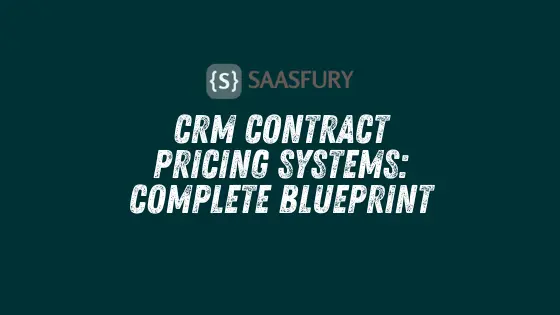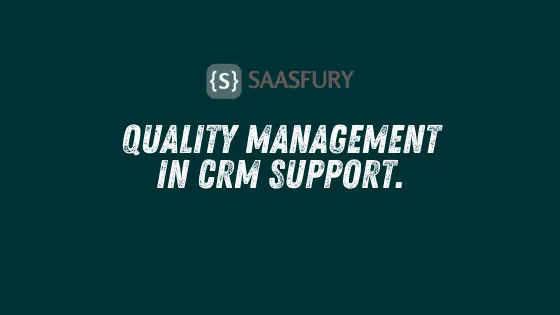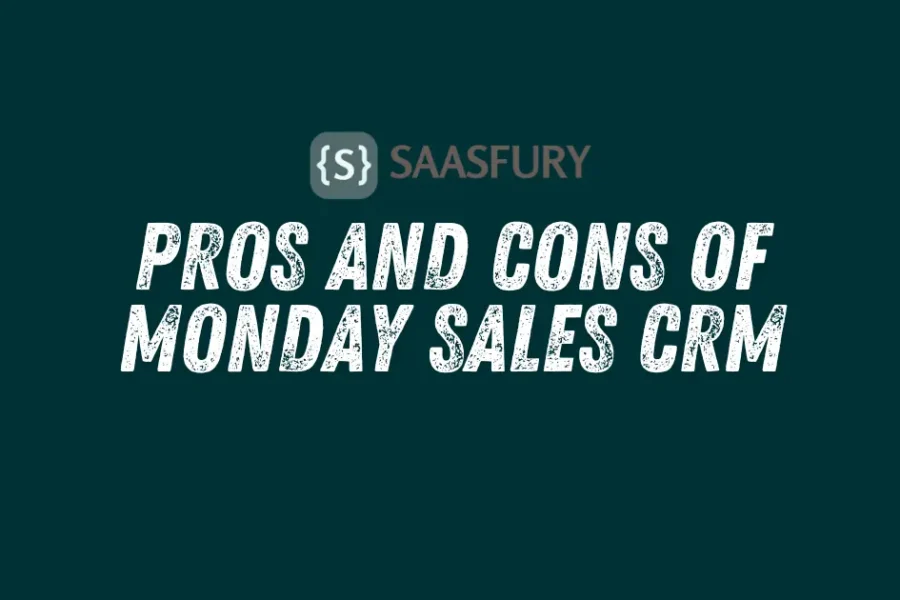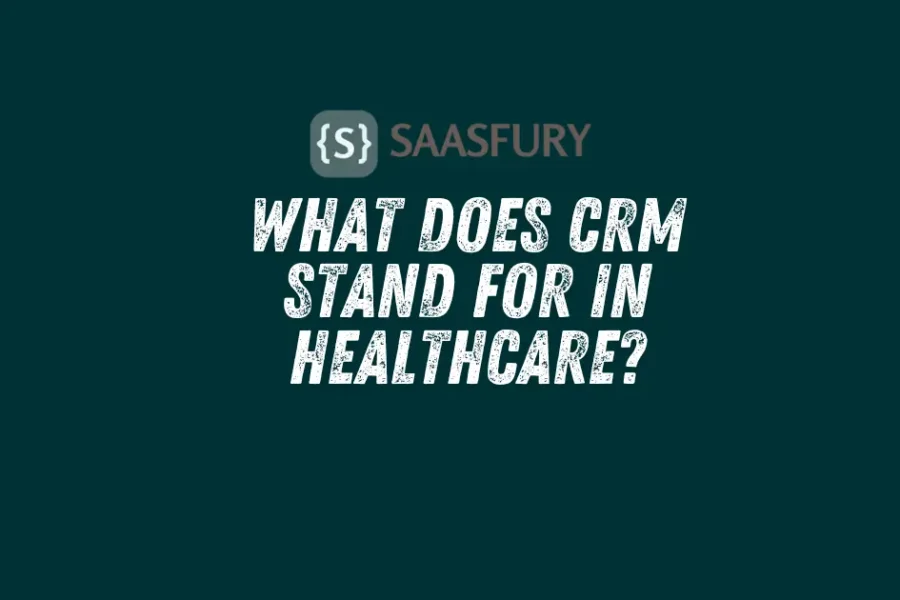Are you struggling with CRM contract pricing? Many businesses find it challenging.
Implementing a CRM contract pricing system can streamline your sales processes. It helps in managing customer relationships and pricing strategies. This blueprint offers a complete guide to get you started. From setting up the system to integrating it with your existing CRM, every step is crucial.
This introduction will help you understand the basic concepts. You’ll learn why a CRM contract pricing system is essential. It will also highlight key benefits and best practices. Dive in to discover a clear path to efficient and effective CRM contract pricing.

Credit: ascendix.com
Table of Contents
Introduction To Crm Contract Pricing Systems
CRM Contract Pricing Systems help businesses manage customer relationships and pricing structures. They combine customer relationship management (CRM) with contract management. This integration ensures that pricing strategies align with customer needs and contracts.
Importance Of Crm Systems
CRM systems play a crucial role in modern business operations. They help companies maintain detailed customer profiles. This data enhances customer interactions and improves sales strategies.
Key benefits of CRM systems include:
- Improved customer service
- Increased sales
- Enhanced customer retention
In the table below, see how CRM systems benefit different departments:
| Department | Benefit |
|---|---|
| Sales | Streamlined sales processes |
| Marketing | Targeted campaigns |
| Customer Service | Better support |
Role Of Contract Pricing
Contract pricing is vital in managing customer agreements. It ensures fair pricing for both the customer and the business. Implementing a solid contract pricing system can lead to:
- Consistent pricing strategies
- Reduced pricing errors
- Increased customer satisfaction
Combining CRM with contract pricing offers several advantages:
- Seamless contract management
- Accurate pricing based on customer data
- Improved negotiation outcomes
CRM Contract Pricing Systems are essential for businesses to thrive in a competitive market. They ensure that customer relationships and pricing align perfectly.
Key Components Of Crm Contract Pricing Systems
Understanding the key components of CRM contract pricing systems is essential for businesses. These systems streamline pricing processes, ensuring accurate and efficient contract management. Let’s dive into the core features and integration capabilities of these systems.
Core Features
CRM contract pricing systems come with essential features that enhance their functionality. Automated pricing calculations reduce errors and save time. Customizable pricing rules allow businesses to set unique criteria.
User-friendly interfaces make the system easy to navigate. Real-time data access ensures up-to-date pricing information. Reporting tools provide insights into pricing trends and performance.
Integration Capabilities
Effective CRM contract pricing systems integrate seamlessly with other business tools. They sync with ERP systems for unified data management. Integration with accounting software simplifies financial tracking.
They connect with sales platforms to streamline the sales process. API support allows for custom integrations, enhancing flexibility. Email and communication tools integration improve customer interaction. These integrations ensure a cohesive and efficient workflow.
Assessing Business Needs
Understanding your business needs is crucial before implementing a CRM contract pricing system. It helps ensure that the system aligns with your goals and processes. Assessing these needs involves a few important steps.
Identifying Requirements
First, list what your business needs from a CRM contract pricing system. Do you need better data management? Or perhaps more accurate pricing models? Pinpoint these needs to create a clear vision.
Talk to different departments. Sales, marketing, and finance teams can offer insights. Their input can highlight specific requirements. This collective approach ensures no aspect is overlooked.
Evaluating Current Systems
Next, review your existing systems. Identify what works well and what doesn’t. This helps in understanding the gaps that need filling.
Analyze the tools you currently use. Are they integrated or isolated? Check for any limitations they might have. This analysis is key to deciding what new features are essential.
By assessing your business needs thoroughly, you can make a well-informed decision. This sets a strong foundation for implementing a CRM contract pricing system.
Choosing The Right Crm Solution
Choosing the right CRM solution is crucial for your business. A good CRM can streamline operations, improve customer relations, and boost sales. The process involves careful consideration of several factors. This section will guide you through key aspects of selecting a CRM solution.
Vendor Selection
Vendor selection is a critical step in implementing a CRM system. You need to evaluate different vendors based on their reputation, customer support, and pricing.
Consider the following factors:
- Reputation: Check online reviews and ask for client references.
- Customer Support: Ensure they offer 24/7 support.
- Pricing: Compare costs and check for hidden fees.
Here is a simple table to help you compare vendors:
| Vendor | Reputation | Support | Pricing |
|---|---|---|---|
| Vendor A | Excellent | 24/7 | $$$ |
| Vendor B | Good | Business Hours | $$ |
| Vendor C | Fair | 24/7 | $ |
Customization Options
Every business has unique needs. Customization options are vital in a CRM system. A flexible CRM can adapt to your specific requirements.
Key customization options to consider:
- Workflows: Tailor workflows to match your processes.
- Reports: Customizable reports to track key metrics.
- Integrations: Ensure the CRM integrates with other tools you use.
Ask these questions when evaluating customization:
- Can I modify fields and forms?
- Are custom dashboards available?
- Is API access provided for integrations?
Choosing the right CRM solution involves detailed evaluation. Make sure it aligns with your business goals and can be customized to fit your needs.
Implementation Strategy
Implementing a CRM contract pricing system can transform business operations. The process requires a well-thought-out strategy to ensure success. This section will detail the key steps in the implementation strategy, focusing on project planning and team assembly.
Project Planning
Effective project planning is crucial. Start by setting clear goals. Understand what you want to achieve with the CRM system. Define the scope of the project. This will help manage expectations and resources.
Create a timeline with realistic deadlines. This keeps the project on track. Break down tasks into smaller, manageable parts. Assign responsibilities to team members. Regularly review progress to identify and address any issues early.
Team Assembly
Building the right team is essential. Select individuals with the right skills and experience. Include members from different departments. This ensures diverse perspectives and expertise. Appoint a project manager to oversee the process.
This person will coordinate tasks and keep the team focused. Ensure open communication within the team. This helps in sharing ideas and solving problems quickly. Provide necessary training to team members. This ensures everyone is on the same page and ready to contribute effectively.
Data Migration And Integration
When implementing a CRM Contract Pricing System, one crucial step is Data Migration and Integration. This phase ensures your data moves smoothly from old systems to new ones. Also, it ensures your CRM integrates seamlessly with existing business applications.
Data Cleanup
Before migrating data, it’s vital to clean it. Remove duplicates and outdated records. This reduces errors during migration. Clean data improves the CRM’s performance and reliability.
Consider these steps for a thorough data cleanup:
- Identify and remove duplicate entries.
- Update outdated information.
- Standardize data formats.
- Validate data accuracy.
Integration With Existing Systems
Integrating your CRM with existing systems is key for a seamless workflow. Ensure your CRM can communicate with your ERP, marketing tools, and other business applications.
Here are some integration points to consider:
- Customer data synchronization across all platforms.
- Automated data entry to reduce manual work.
- Unified customer profiles for better insights.
- Real-time updates to ensure data consistency.
Use APIs and middleware to facilitate integrations. This ensures your CRM works well with other systems.
Check the integration capabilities of your CRM provider. Make sure they support the necessary connections.
Training And Change Management
Implementing a new CRM contract pricing system requires careful training and change management. Without proper training, users may feel overwhelmed. Change management helps in easing the transition. Below, we explore key elements of this process.
User Training Programs
Effective user training programs are essential. They ensure that employees understand the new system. Consider the following steps:
- Initial Workshops: Introduce the system and its benefits.
- Hands-on Sessions: Allow users to practice with the system.
- Ongoing Support: Provide resources and help desks for queries.
Use a mix of training methods. This can include video tutorials, written guides, and interactive sessions. Ensure that all materials are easy to understand.
Managing Resistance To Change
Change can be difficult. Employees may resist new systems. Managing this resistance is crucial. Consider the following strategies:
- Communicate Clearly: Explain why the change is necessary.
- Involve Employees: Get feedback and involve them in the process.
- Provide Support: Offer emotional and technical support.
Address concerns promptly. Show how the new system will improve their work. This builds trust and eases the transition.
| Training Method | Benefits |
|---|---|
| Workshops | Hands-on experience |
| Video Tutorials | Visual learning |
| Written Guides | Reference material |
| Interactive Sessions | Engaging and interactive |
By focusing on training and change management, you can ensure a smooth implementation of your CRM contract pricing system. Employees will feel supported and confident in using the new system.
Testing And Quality Assurance
Testing and Quality Assurance ensure your CRM contract pricing system works perfectly. This phase verifies that all functionalities operate correctly. It also confirms the system meets user needs. Proper testing helps avoid future issues and boosts user satisfaction.
System Testing
System testing checks each feature thoroughly. It examines the whole CRM system. This testing finds bugs and errors. Fixing these issues improves the system’s reliability. System testing includes functional and non-functional tests. These tests ensure the system performs well under different conditions.
User Acceptance Testing
User Acceptance Testing (UAT) involves real users. They test the system in real-world scenarios. UAT ensures the system meets user needs and expectations. Users provide feedback on the system’s performance. This feedback helps in making necessary adjustments. UAT is crucial for a successful CRM implementation.
Post-implementation Support
Once your CRM contract pricing system is up and running, the work is not over. Post-implementation support is crucial for long-term success. This phase ensures that the system remains effective and continues to meet your business needs.
Ongoing Maintenance
Regular maintenance keeps your CRM system in top shape. It includes software updates, bug fixes, and security patches. These tasks ensure the system runs smoothly and securely.
Here are some key tasks involved in ongoing maintenance:
- Software Updates: Keep the software up-to-date with the latest features and improvements.
- Security Patches: Apply security updates to protect against threats.
- Performance Monitoring: Regularly check system performance to identify and resolve issues.
Continuous Improvement
A good CRM system evolves with your business. Continuous improvement helps in adapting the system to changing needs. This can involve adding new features, refining existing ones, and training staff on new functionalities.
Steps to ensure continuous improvement include:
- Feedback Collection: Gather user feedback to identify areas for improvement.
- Feature Enhancements: Implement new features based on user needs and market trends.
- Regular Training: Conduct training sessions to keep staff updated on new features.
By focusing on ongoing maintenance and continuous improvement, you ensure your CRM contract pricing system remains effective and valuable for your business.

Credit: www.slidegeeks.com
Measuring Success
Measuring the success of your CRM contract pricing system is essential. It helps ensure that your implementation efforts are on the right track. This section will cover key performance indicators and the importance of feedback and adjustments.
Key Performance Indicators
Key performance indicators (KPIs) are vital metrics. They help track the effectiveness of your CRM contract pricing system. Examples include customer satisfaction, contract renewal rates, and sales growth. These KPIs give a clear picture of how well the system performs.
Customer satisfaction reflects how happy clients are with your pricing. High satisfaction often leads to repeat business. Contract renewal rates show if clients are willing to continue the relationship. A high renewal rate indicates trust and value. Sales growth measures the increase in revenue over time. It shows if the pricing strategy drives sales.
Feedback And Adjustments
Gathering feedback is essential for ongoing success. Collect input from users and clients. This information helps identify areas that need improvement. Regular surveys, user interviews, and feedback forms can be useful tools.
Once feedback is collected, make necessary adjustments. Use the insights to tweak the pricing system. Address any issues and enhance the user experience. Continuous improvement ensures the system remains effective and relevant.

Credit: www.zoho.com
Frequently Asked Questions
What Is A Crm Contract Pricing System?
A CRM contract pricing system is a tool used to manage and automate contract pricing. It helps businesses streamline pricing strategies and ensure consistency.
How Does Crm Contract Pricing Benefit Businesses?
CRM contract pricing benefits businesses by improving pricing accuracy. It also enhances customer satisfaction, reduces errors, and saves time by automating complex pricing processes.
What Are Key Features Of Crm Contract Pricing Systems?
Key features of CRM contract pricing systems include automated pricing, contract management, real-time data analysis, and integration with other business tools.
How To Implement A Crm Contract Pricing System?
To implement a CRM contract pricing system, first assess your needs. Then, choose the right software, integrate it with existing systems, and train your team.
Conclusion
Implementing CRM contract pricing systems can transform your business operations. Follow the blueprint closely. Understand each step. Stay consistent. Watch your efficiency grow. Simplify tasks. Improve customer satisfaction. Your team will appreciate the clarity. Save time. Increase accuracy. Gain better insights.
Remember, successful implementation requires patience. Stay focused. Enjoy the benefits of a well-structured system. Happy implementing!






Leave a Comment